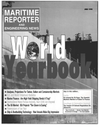
Page 44: of Maritime Reporter Magazine (June 1998)
Read this page in Pdf, Flash or Html5 edition of June 1998 Maritime Reporter Magazine
Host Of Factors Conspire To Facilitate Bulk Market Stagnation
Drewry T JL T
Ihe opening months of 1998 have been trauma- tizing for dry bulk ship owners. Freight rates have col- lapsed, there has been talk of applications for lay-up berths and, to cap it all, the progressive draft limit cuts imposed by the Panama Canal authorities in the light of the El Nino phenom- enon have put the Panamax sector in particular in a quandary.
Yet, six months or so previously the outlook had appeared so much rosier. In terms of cargo volumes, 1997 had been a phenomenal year.
Iron ore trade surged through the 400 million tons mark — a figure that many had regarded as an unbreachable ceiling, especially as scrap- charged mini mills rather than huge blast fur- naces and integrated mills appeared to be the way forward.
A key factor was Chinese import demand, this
being borne out further by the much smaller
traffic improvement for coking coal, the other
major steelmaking raw material. In addition,
steam coal trade maintained its seemingly
inexorable upward path Furthermore, on the
supply side the order backlog for new ships was
falling. At long last, restraint by ship owners
by Mal Drewry Shipping Consultants ltd.
looked to be about to pay dividends — 1997 was
going to be the start of the good times, the up-
cycle was here.
Then, suddenly, the bubble burst as the Asian
"powerhouse economies" on which most near
and medium term optimism was built, started
to unravel badly. Economists began slashing
growth rate expectations and the market,
which is heavily influenced by sentiment, got
nervous. South East Asia started the jitters
but their overall trade volume is not that great.
Nevertheless, they were behind a significant
number of independent power projects (IPPs) -
which were going to require millions of tons of
coal. Some supply contracts were in place and,
crucially, ships were on order. Probably, if the
problems had been limited to this region, the
dry bulk market could have ridden out the
storm. However, the vital Japanese market —
already sluggish — could not (and still does not
seem able to) shake off its lethargy. Worse still,
however, the crisis impacted in a major way in
South Korea. When a country responsible for
perhaps seven to eight percent of dry bulk
demand catches a cold, everybody is likely to be
sneezing.
With hindsight, as ever, some claimed to have
seen the crisis coming. There were signs —
extended periods before bills were paid, for
example — but such market intelligence was
not widely available. Most, if they are honest,
will have been taken by surprise.
How serious is the calamitous market of early
1998?
For charterers, rates are very low — which,
naturally, suits them. This said, however, very
narrow freight differentials do not necessarily
enhance the competitive advantage of end-
users of dry bulk commodities. Charterers also
know that the advantage they hold is of little
value if owners would rather lay up their ships
than take loss making rates.
For owners, rates are very low — which, nat-
urally, does not suit them. There have been
claims that rates — as typified by the Baltic
Freight Index (BFI) falling below the 1,000
points mark — are in reality as bad as during
the disastrous market of 1986, when the cata-
log of dry bulk ship owners going to the wall
still remains too painful for many to contem-
plate. If one allows for inflationary factors
between 1986 and 1987, there may be some
truth in this. There are, however, other points
to consider.
The 1986 nadir followed a market decline that
had seen rates hemorrhaging for at least five
years. In 1988, troubled owners — if prudent
— ought to have some reserves to fall back on.
With the summer months inevitably seeing a
slacker market and El Nino continuing to bite,
there is near term pain for dry bulk ship own-
ers.
But beyond then?
The camps divide into optimists and pes-
simists. The former see the problems in Asia as
a short term correction. Things will stabilize
in, say, 12-18 months and then the growth path
will resume but at a less frenetic pace. The lat-
ter fear the Asia contagion will spread and
undermine other markets. A close watch on
economic performance in the EU and U.S. will
be crucial.
As Table 1 has indicated (see next page), with
economic growth still predicted (albeit more
modestly) it is still possible to envisage demand
being maintained. Nearly two billion tons
remains a prospect.
However, for 1998 and 1999, the orderbook
averages out at over one new Handymax and
Panamax bulk carrier a week. For Capesizes,
the figure might be nearer to one every two
weeks, and 1998 also has a notable backlog of
Handysize ships scheduled for delivery.
Pictured above is Daewoo-built bulk carrier SG Prosperity. Despite its moniker, the bulk carrier market has been anything but pros-
perous for owners who have helplessly watched a good market turn bad in a mere six months.
44 Maritime Reporter/Engineering News

 43
43

 45
45
